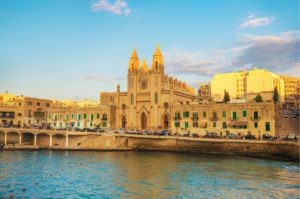Words by Kirstie Pickering
While hotspots like France, Spain and Italy offer some of the most popular summer sights for European holidaymakers, venturing off the beaten path this season is becoming simpler thanks to expanding private and business aviation facilities across the continent.
From beach breaks to hiking trips, these five destinations in Europe offer a chance to escape the crowded beaches via private aviation.
Malta
Nestled in the Mediterranean between Sicily and the North African coast, Malta is a small island country famous for its architecture, coastline and diving sites.
Many visitors flock to St Julian’s, a seaside town on the northeast of the island that offers luxury casinos, hotels at Portomaso Marina, a Blue Flag beach named St George’s Bay, and historical landmarks such as the Church of Our Lady of Mount Carmel.

Malta International Airport is the only airport on the island that serves charter flights. It is also home to a VIP terminal that facilitates quick transfers from private jet to ground transport. The airfield has two runways and is just 3 miles (5km) from Valetta, the capital.
DC Aviation is a business aviation provider in Malta, offering aircraft management, FBO and charter services at its international airport. “Business aviation has been growing constantly during the past 15 years, especially during the Covid years,” says Stanley Bugeja, managing director at
DC Aviation.
“However, as airline schedules have returned to normality this year we have experienced a small decline in
activity, but we are expecting a busy summer ahead.”
Business aviation is important to Malta as an island nation that has significant international finance, online gambling, yachting and manufacturing sectors. Bugeja notes that business jet parking can be a challenge at
Malta International, but DC Aviation works with its customers to resolve any issues.
“Business aviation provides point-to-point connections to the global industries contributing to the sustainable economic growth of the island,” Bugeja says.
“Malta has a lot to offer in all months of the year. From a tourist perspective, one is hard pressed to find such a concentration of history in such a small space elsewhere. There are temples older than Stonehenge and the pyramids, as well as some very beautiful beaches.”
Romania
 While not widely known as a summer holiday destination, Romania has beaches, mountains, and temperatures that reach up to 35˚C during summer.
While not widely known as a summer holiday destination, Romania has beaches, mountains, and temperatures that reach up to 35˚C during summer.
Its capital Bucharest is a natural pitstop for any tourist, with iconic landmarks like the Romanian Arch of Triumph, Victory Square and the Romanian Athenaeum, as well as an abundance of huge parks.
If you’re looking for something quieter, Transylvania offers green landscapes, historical towns and points of interest, and Retezat National Park is home to glacial lakes, waterfalls and mountain peaks.
There are multiple airports that serve private aviation, with the key hub being Henri Coandă International Airport near Bucharest. The airport’s only FBO and private terminal is operated by Tiriac Air.
The Romanian charter operator, which owns the business terminal operates a fleet of three aircraft and one helicopter runs a Part 145-approved maintenance base and has hangar facilities. It also offers comprehensive services for customers such as handling and extended services for all types of aircraft, a VIP waiting room, fully equipped crew rest spaces, hotel and limousine reservation for crew and passengers, a meeting room and 24 hour service.
“Private and business aviation facilities in Romania are generally well-equipped and offer a range of services that meet the needs of private and corporate clients,” says Bianca Florian, sales and marketing coordinator at Tiriac Air.
“These include aircraft storage, maintenance and repairs, as well as refueling and ground handling. Many facilities also offer additional services such as catering, passenger lounges and ground transportation arrangements.
“Besides Tiriac Air’s general aviation terminal, there are several additonal airports throughout the country that cater to private and business aviation, such as Cluj-Napoca International Airport and Timisoara Trian Vuia International Airport.”
Private aviation plays an important role in Romania’s tourism industry by providing quick and convenient access to the country’s attractions in more remote areas.
Depending on their citizenship, passengers may be required to show different documents at the port-of-entry. Travelers from the USA, Canada, Australia, New Zealand and most European countries do not need an entry visa for Romania, providing the duration of a stay is no more than 90 days accumulated during a single visit or multiple visits within a six month period.
“With Covid-19 under control and most travel restrictions lifted, the levels of activity in Romania are already increasing and we expect to keep this trend during the summer,” says Florian.
“There are many events like festivals and sporting events scheduled in Romania for this summer that will contribute to the attraction of a large number of tourists.”
Croatia and Montenegro
 Located on the Balkan peninsula, both Croatia and Montenegro offer much to see and do for summer holidaymakers. In Croatia, the waterfront cities of Dubrovnik and Split offer a mix of modern life and ancient history, as well as their beaches and water sports.
Located on the Balkan peninsula, both Croatia and Montenegro offer much to see and do for summer holidaymakers. In Croatia, the waterfront cities of Dubrovnik and Split offer a mix of modern life and ancient history, as well as their beaches and water sports.
In Montenegro, tourists flock to the UNESCO World Heritage site of Kotor. Situated at the end of the scenic Kotor Bay, the city is filled with medieval architecture and historic monuments and has over 2.5 miles (4km) of city walls. For those more adventurous, the country also offers mountainous landscapes that are ideal for hiking in the summer months.
Most of the major airports in Croatia have separate general aviation terminal (GAT) facilities, including Zagreb and Dubrovnik. Split has a separate section inside the main terminal for general aviation. Zadar has a GAT next to the main terminal, while all the other major seasonal airports in Croatia – Pula, Rijeka and Brač – have just a main terminal.
Euro Jet has facilities and representatives located at every major airport in Croatia and Montenegro. In Zagreb, Split, Dubrovnik and Tivat it also offers customers a Euro Jet lounge and office facility.
“Tourism is one of the biggest industries for both Croatia and Montenegro,” says Gareth Danker, director of sales at Euro Jet. “During the summer season, airports can get really busy.
“For example, because of the airport’s layout, the ramp at Split Airport has limited space and nearly all business aviation aircraft have a narrow slot and are required to turn around very quickly. This can be challenging, especially for aircraft with passengers getting on a yacht and departing for a couple weeks. Fortunately, we have several airports in the region where the aircraft can park.”
Zadar is another airport that can offer a long term parking option during the summer. Just 45 minutes from Split Airport, the recent construction of a direct highway connecting the two locations makes the journey straightforward. Zadar also has its own yacht harbor, which is just 10 minutes away from the airport.
“Tivat is similar to Split in that both have major ports nearby and limited parking,” says Danker. “Tivat does have a handful of parking locations available, though you should always assume you will have to reposition as those spots are limited. Tivat also has no runway lights, so the airport only operates during daylight hours.”

Danker believes having a ground support company to navigate these challenges is essential for smooth operations and helps to avoid private aviation passengers getting stuck in long
security and customs lines alongside commercial travelers.
“Croatia and Montenegro can get crowded in the summer, but not in an unbearable way like the Western European tourist locations,” Danker says. “The prices are also far lower. Hotels are not cheap, but certainly less than in London and Paris.
“Additionally, the fresh seafood and its prices are unheard of in Western Europe. And to top it all– it is beautiful!
“The black mountains of Montenegro in particular are spectacular, and both Croatia and Montenegro are filled with small fishing villages, scenic mountains, beaches and extremely beautiful lush islands.”
Bulgaria
 Whether climbing to mountain summits or relaxing on the beaches of the Black Sea, Bulgaria is a summer holiday destination that could suit any type of traveler.
Whether climbing to mountain summits or relaxing on the beaches of the Black Sea, Bulgaria is a summer holiday destination that could suit any type of traveler.
Nature lovers can head 62 miles (100km) south of the capital Sofia to complete the Seven Rila Lakes hike in Rila National Park, which is suitable for all abilities. In mid-August, visitors to the lakes can witness the Paneurhythmy dance, where hundreds of people dress in white and dance close to the Park’s Kidney Lake.
For those looking for a coastal stay, Bulgaria is home to a huge number of beachside resorts including those at Albena, Sozopol and Pomorie.
There are multiple airports spread across the country, with Sofia International Airport being the main hub. Part of Sky Valet Connect and Paragon Aviation Group, Omega Aviation offers a VIP lounge for general aviation travelers at Sofia.
Omega is a licensed handler at the airport and is focused solely on business aviation needs. It also offers ground handling services at the airports of Varna, Burgas, Plovdiv and Gorna Oryahovitsa.
Before heading to the country, all operators must consider getting permission from Bulgaria’s Civil Aviation Administration, which takes up to five working days to obtain. “Bulgaria is part of the the EU but not of Schengen, so all passengers and crew must pass border control,” says Toni Totov, CEO at Omega Aviation.
“We expect the importance of private aviation to grow as Bulgaria is expected to enter Schengen and the Eurozone next year, and we hope that foreign companies will recognize Bulgaria’s potential for investment and development.
“The tourism sector in Bulgaria has developed significantly in the last couple of years. There has been a shift of focus from all-inclusive resorts to more exclusive five-star developments, as well as a boom in openings of fine dining establishments.”
Totov notes that private and business aviation facilities in Bulgaria are not as developed as in other countries, but Omega Aviation is working closely with airport operators on developing these to international standards. At Sofia, Omega is the only handler with CO2-neutral airside movement after upgrading to fully electric vehicles.
“Tourism is expected to grow now all restrictions from the pandemic are lifted,” concludes Totov. “We are witnessing business aviation traffic getting back to pre-pandemic levels and potentially
even higher.”





